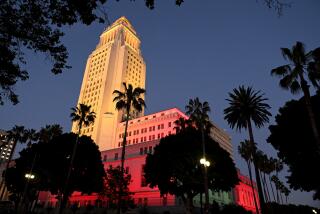A Buoyant City Hall Thinks Big : Tall Buildings, Capitol Plans
- Share via
A spring and early summer of voting, both by the public and the Los Angeles City Council, has put a tight Tom Bradley lid on City Hall, making it safe for the mayor to embark on another campaign for governor.
And a second gubernatorial campaign certainly seems to be the plan, judging from conversations with Capitol-struck Bradley aides willing to trade Los Angeles’ seasonal smog for Sacramento’s 100-degree-plus summer heat.
The change of attitude toward a governor’s race is noticeable. Before Bradley’s crushing defeat of City Councilman John Ferraro in May, talk of another race against Gov. George Deukmejian was considered bad taste because of Ferraro’s charge that Bradley was more interested in being governor than mayor. But now the Bradleyites are busily devising winning campaign scenarios.
One reason for the high spirits might be that Bradley’s reelection, and the events that followed it, have assured the continuation of some of his most important policies, no matter how much time he spends on the statewide campaign trail.
These policies have always been central to his Administration. Generally, they provide for intensive development downtown, along with creation of a friendly environment for development in other parts of the city.
A prime example is Bradley’s complete support of the Community Redevelopment Agency and its pursuit of a downtown packed with high rises, brushing aside fears of congestion raised by planning and transportation experts.
Bradley’s overwhelming defeat of Ferraro assured the mayor’s continuing dominance of City Hall. Politicians who disagree with him continue to be afraid to go public with their criticism.
His victory was reinforced by the City Council, which reelected Pat Russell, a Bradley ally, as president.
Russell and Bradley agree on development. Both are firmly wedded to the view that today’s big cities can prosper only by continued construction of the buildings, stores, and housing that create jobs and increase tax revenues.
Russell opposes what she considers the extreme view of those who say the way to limit congestion is to limit construction of so many big buildings downtown, on the Westside, along Ventura Boulevard in the San Fernando Valley and around Los Angeles International Airport in Russell’s own council district.
She is the author of a plan that permits large-scale development while forcing the developers to finance congestion-easing measures, such as new freeway off-ramps and street widening, as well as to promote ride-sharing among employees in the new developments. Some developers are not happy about such a compromise, but it does permit them to continue building.
The importance of Russell’s reelection to the Bradley policies became clear last week when she announced the membership and chairs of council committees.
One of her most significant decisions was to keep the council’s newest member, Michael Woo, off the Planning and Environment Committee, which makes the key development decisions. Woo, who represents the 13th District, which includes Hollywood, a key battleground in the congestion-development fight, had requested a seat on the committee.
One of Woo’s main issues in his defeat of incumbent Peggy Stevenson was his charge that Stevenson was turning over Hollywood to high-rise developers who would wipe out old residential neighborhoods. An important part of the coalition that elected him were representatives of neighborhood organizations, which tend to be anti-development, environmentally oriented groups. These groups, powerful in the late ‘60s and early ‘70s, have not been especially visible around City Hall in recent years. But the heavy construction on the Westside and in the San Fernando Valley, along with the prospect of tall buildings in Hollywood and other areas, have revived the neighborhood groups and they are considered to be a rising political force in Los Angeles.
Rather than put Woo on the planning committee, Stevenson put herself and pro-development Councilmen Howard Finn and Robert Farrell on the panel.
That means the neighborhood groups will be denied Woo’s voice during the the committee sessions that shape planning and zoning legislation. Woo was trained as a planner and during the campaign proved an articulate speaker on the subject.
Woo’s absence from the committee will become particularly important in the next few months. The council is beginning to implement zoning ordinances that will result in limits on construction in about a quarter of the city.
The ordinances are needed to bring zoning into conformance with a city general plan that generally reflects the views of the neighborhood organizations. The neighborhood groups shaped that plan several years ago and pushed it through. But it was ignored by the council and the Administration until a lawsuit by the Center for the Law in the Public Interest forced the city to adhere to the plan. What is important is how quickly the council and the Bradley Administration do so. Developers want them to take their time so they can obtain permits for big buildings before the limits take effect. With the present structure of the Planning Committee, the developers might get much of what they want, without lengthy debate or controversy.
What the mayor wants is a quiet City Hall, if he begins those San Diego to Eureka trips necessary for a statewide campaign. He seems to have it now. The danger is that Los Angeles will be denied the debate that is needed on development issues, which are sure to dominate City Hall in the months ahead.
More to Read
Sign up for Essential California
The most important California stories and recommendations in your inbox every morning.
You may occasionally receive promotional content from the Los Angeles Times.













